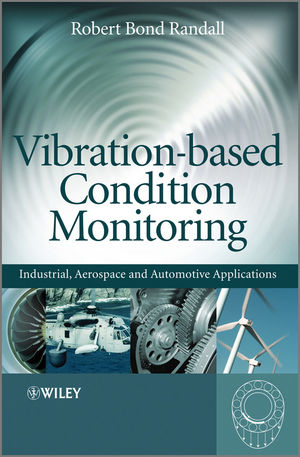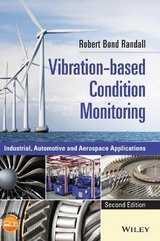
Vibration–based Condition Monitoring
John Wiley & Sons Inc (Verlag)
978-0-470-74785-8 (ISBN)
- Titel erscheint in neuer Auflage
- Artikel merken
"Without doubt the best modern and up-to-date text on the topic, wirtten by one of the world leading experts in the field. Should be on the desk of any practitioner or researcher involved in the field of Machine Condition Monitoring" Simon Braun, Israel Institute of Technology Explaining complex ideas in an easy to understand way, Vibration-based Condition Monitoring provides a comprehensive survey of the application of vibration analysis to the condition monitoring of machines. Reflecting the natural progression of these systems by presenting the fundamental material and then moving onto detection, diagnosis and prognosis, Randall presents classic and state-of-the-art research results that cover vibration signals from rotating and reciprocating machines; basic signal processing techniques; fault detection; diagnostic techniques, and prognostics.
Developed out of notes for a course in machine condition monitoring given by Robert Bond Randall over ten years at the University of New South Wales, Vibration-based Condition Monitoring: Industrial, Aerospace and Automotive Applications is essential reading for graduate and postgraduate students/ researchers in machine condition monitoring and diagnostics as well as condition monitoring practitioners and machine manufacturers who want to include a machine monitoring service with their product. * Includes a number of exercises for each chapter, many based on Matlab, to illustrate basic points as well as to facilitate the use of the book as a textbook for courses in the topic. * Accompanied by a website www.wiley.com/go/randall housing exercises along with data sets and implementation code in Matlab for some of the methods as well as other pedagogical aids. * Authored by an internationally recognised authority in the area of condition monitoring.
Robert Bond Randall, University of New South Wales, Australia. Having had a long career in industry, for the most part with Brüel & Kjær, Robert (Bob) Randall moved to academia in 1988 and is now a Visiting Emeritus Professor at the University of New South Wales. He currently serves as editor of the journal Mechanical Systems and Signal Processing, and has authored 2 books, published by Brüel & Kjær, Frequency Analysis and Mechanical Vibration and Shock Measurements. He is a global leader in the field of vibration analysis and signal processing applied to machine condition monitoring.
Foreword xi About the Author xiii Preface xv 1 Introduction and Background 1 1.1 Introduction 1 1.2 Maintenance Strategies 2 1.3 Condition Monitoring Methods 3 1.3.1 Vibration Analysis 3 1.3.2 Oil Analysis 4 1.3.3 Performance Analysis 5 1.3.4 Thermography 5 1.4 Types and Benefits of Vibration Analysis 6 1.4.1 Benefits Compared with Other Methods 6 1.4.2 Permanent vs Intermittent Monitoring 6 1.5 Vibration Transducers 8 1.5.1 Absolute vs Relative Vibration Measurement 8 1.5.2 Proximity Probes 9 1.5.3 Velocity Transducers 12 1.5.4 Accelerometers 13 1.5.5 Dual Vibration Probes 17 1.5.6 Laser Vibrometers 18 1.6 Torsional Vibration Transducers 18 1.6.1 Shaft encoders 19 1.6.2 Torsional Laser Vibrometers 19 1.7 Condition Monitoring the Basic Problem 20 References 23 2 Vibration Signals from Rotating and Reciprocating Machines 25 2.1 Signal Classification 25 2.1.1 Stationary Deterministic Signals 28 2.1.2 Stationary Random Signals 29 2.1.3 Cyclostationary signals 30 2.2 Signals Generated by Rotating Machines 30 2.2.1 Low Shaft Orders and Subharmonics 31 2.2.2 Vibrations from Gears 40 2.2.3 Rolling Element Bearings 47 2.2.4 Bladed Machines 52 2.2.5 Electrical Machines 52 2.3 Signals Generated by Reciprocating Machines 56 2.3.1 Time Frequency Diagrams 57 2.3.2 Torsional Vibrations 60 References 61 3 Basic Signal Processing Techniques 63 3.1 Probability Distribution and Density 63 3.2 Fourier Analysis 66 3.2.1 Fourier Series 66 3.2.2 Fourier Integral Transform 69 3.2.3 Sampled Time Signals 69 3.2.4 The Discrete Fourier Transform 71 3.2.5 The Fast Fourier Transform 72 3.2.6 Convolution and the Convolution Theorem 74 3.2.7 Zoom FFT 84 3.2.8 Practical FFT Analysis 86 3.3 Hilbert Transform and Demodulation 95 3.3.1 Hilbert Transform 95 3.3.2 Demodulation 96 3.4 Cepstrum Analysis 103 3.4.1 Terminology and Definitions 105 3.4.2 Typical Applications of the Cepstrum 108 3.4.3 Practical Considerations with the Cepstrum 110 3.5 Digital Filtering 114 3.5.1 Realization of Digital Filters 115 3.6 Deterministic/Random Signal Separation 117 3.6.1 Order Tracking 117 3.6.2 Time Synchronous Averaging 120 3.6.3 Linear Prediction 122 3.6.4 Adaptive Noise Cancellation 125 3.6.5 Self-adaptive Noise Cancellation 125 3.6.6 Discrete/Random Separation DRS 128 3.7 Time Frequency Analysis 129 3.7.1 The Short Time Fourier Transform 130 3.7.2 The Wigner Ville Distribution 130 3.7.3 Wavelet Analysis 131 3.8 Cyclostationary Analysis and Spectral Correlation 134 3.8.1 Spectral Correlation 135 3.8.2 Spectral Correlation and Envelope Spectrum 138 3.8.3 Wigner Ville Spectrum 139 References 139 4 Fault Detection 143 4.1 Introduction 143 4.2 Rotating Machines 143 4.2.1 Vibration Criteria 143 4.2.2 Use of Frequency Spectra 148 4.2.3 CPB Spectrum Comparison 149 4.3 Reciprocating Machines 155 4.3.1 Vibration Criteria for Reciprocating Machines 155 4.3.2 Time Frequency Diagrams 156 4.3.3 Torsional Vibration 160 References 165 5 Diagnostic Techniques 167 5.1 Harmonic and Sideband Cursors 167 5.1.1 Examples of Cursor Application 167 5.2 Minimum Entropy Deconvolution 169 5.3 Spectral Kurtosis and the Kurtogram 172 5.3.1 SK Definition and Calculation 172 5.3.2 Use of SK as a Filter 174 5.3.3 The Kurtogram 176 5.4 Gear Diagnostics 178 5.4.1 Techniques Based on the TSA 179 5.4.2 Transmission Error as a Diagnostic Tool 181 5.4.3 Cepstrum Analysis 187 5.4.4 Separation of Spalls and Cracks 196 5.4.5 Diagnostics of Gears with Varying Speed and Load 199 5.5 Rolling Element Bearing Diagnostics 200 5.5.1 Signal Models for Bearing Faults 203 5.5.2 A Semi-automated Bearing Diagnostic Procedure 207 5.6 Reciprocating Machine and IC Engine Diagnostics 214 5.6.1 Time Frequency Methods 214 5.6.2 Cylinder Pressure Identification 217 References 225 6 Fault Trending and Prognostics 229 6.1 Introduction 229 6.2 Trend Analysis 229 6.2.1 Trending of Simple Parameters 230 6.2.2 Trending of Impulsiveness 234 6.3 Determination of Spall Size in Bearings 238 6.4 Advanced Prognostics 243 6.4.1 Physics-Based Models 244 6.4.2 Data-Driven Models 245 6.4.3 Hybrid Models 247 References 250 Appendix: Exercises and Tutorial Questions 253 A.1 Introduction and Background 253 A.1.1 Exam Questions 253 A.2 Vibration Signals from Machines 254 A.2.1 Exam Questions 254 A.3 Basic Signal Processing 256 A.3.1 Tutorial and Exam Questions 256 A.4 Fault Detection 270 A.4.1 Tutorial and Exam Questions 270 A.4.2 Assignment 273 A.5 Diagnostic Techniques 275 A.5.1 Tutorial and Exam Questions 275 A.5.2 Assignments 280 A.6 Prognostics 284 A.6.1 Tutorial and Exam Questions 284 Index 285
| Erscheint lt. Verlag | 21.1.2011 |
|---|---|
| Verlagsort | New York |
| Sprache | englisch |
| Maße | 177 x 251 mm |
| Gewicht | 686 g |
| Themenwelt | Technik ► Elektrotechnik / Energietechnik |
| Technik ► Maschinenbau | |
| ISBN-10 | 0-470-74785-4 / 0470747854 |
| ISBN-13 | 978-0-470-74785-8 / 9780470747858 |
| Zustand | Neuware |
| Haben Sie eine Frage zum Produkt? |
aus dem Bereich



